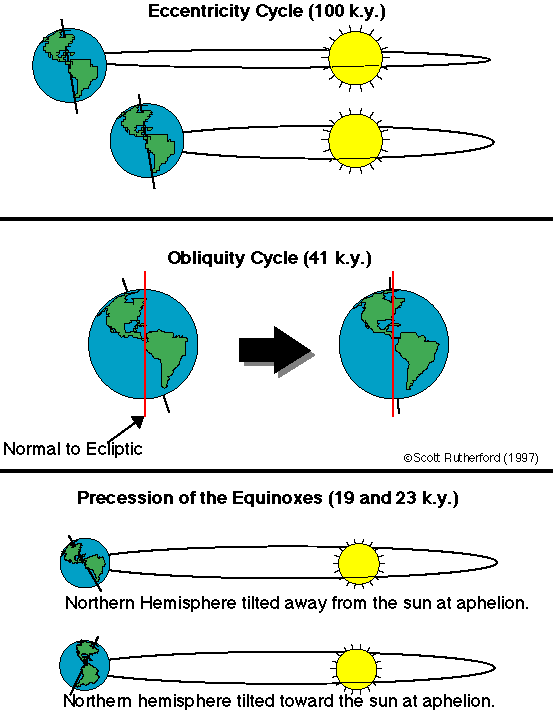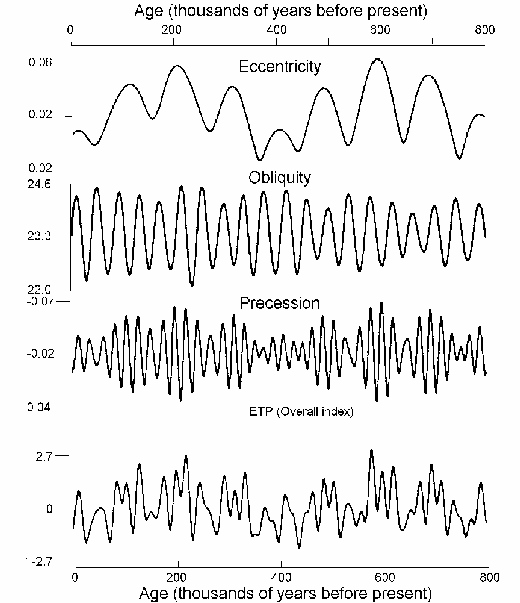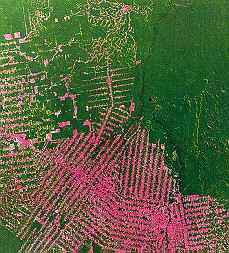From a human perspective, climate change is the departure from the expected average weather or climate normals (temperature and precipitation) for a given place and time of year.
In contrast with extreme events, such as snowfall in Florida, climate change is the long-term shift in the expected or average weather.
Climate change reflects significant shifts in the mean state of the atmosphere-ocean-land system that results in shifts in the atmosphere and ocean circulation patterns, which in turn impacts regional weather.
From the paleoclimate perspective, climate change is normal and part of the earth's natural variability related to interactions among the atmosphere, ocean, and land, as well as changes in the amount of solar radiation reaching the earth.
The geologic record includes a plethora of evidence for large-scale climate changes.
Evidence for climate fluctuations over all scales of time is conclusive.
Possible causes of long-period climatic variations can be grouped in three broad categories:
There are two proposed mechanisms for astronomically-forced climate change:
 |
2. Astronomical causes regarding the Earth-orbit changes.
Changes in solar radiation available at different latitudes and seasons which accompany regular cyclical variations in the Earth's orbital arrangements:
Check out the Department of Geography, Okanagan University College, web pages for animations. The information in this web link and the detailed figures shown on this page were included for completeness. Because we are just touching on this material in class, you will not be expected to fully understand all of the details.
 |
At the moment we are closest to the Sun during northern hemisphere winters, leading to slightly milder winter and summers in the northern hemisphere but harsher winters and summers in the southern hemisphere.
 |
The changes in solar energy at the top of the atmosphere were first computed by the a Serbian scientist Milutin Milankovitch about 1930. He was convinced that these orbital changes were the cause of the Ice Ages.
However, today scientists believe that these changes alone are not sufficient to explain the occurrence of the ice ages, although many still believe that these orbital changes are responsible for "triggering" the ice age cycles. In other words, the orbital changes push the climate system in a particular direction. Once pushed, positive feedbacks in the climate system may then result in full blown ice age cycles.
We will mention two changes in atmospheric composition that can change climate:
 |
The eruptions of El Chichon in 1982 and Mt. Pinatubo in 1991 produced large changes in the aerosol content of the stratosphere and upper troposphere. The effect of both volcanos was to produce a global cooling effect of a few tenths of a degree Celsius.
First major eruption of Pinatubo, from Clark Air Base. Philippines. June 12, 1991. (Images and captions from USGS).
The satellite image below shows the distribution of Mount Pinatubo's sulfur dioxide and dust aerosol plume (red and yellow areas) between June 14 and July 26, 1991.
Approximately 45 days after the eruption, the aerosol plume completely circled the Earth around the equator forming a band 20 to 50 degrees of latitude wide. Areas outside this band were clear of volcanic aerosols. Within a year, the sulfur dioxide continued to migrate towards the North and South Pole until it covered the entire Earth because of the dominant poleward flow of stratospheric winds (stratospheric winds circulate from the equator to the polar vortices at the North and South Poles).
 |
| Distribution of Mount Pinatubo's sulfur dioxide and dust aerosol plume (red and yellow areas) between June 14 and July 26, 1991. |

|
| Remains of dust from ancient eruptions can be found within layers of ice in Greenland and other ice-sheets in high latitudes. |
Counting ash grains in ice layers from ice drill cores, such as the Vostok core, allow a precise record of major volcanic eruptions to be determined.
2. Changing concentrations of greenhouse gasesThis will affect the strength of the greenhouse effect. Over geological timescales, we do have evidence that the concentrations of greenhouse gases in the atmosphere (especially carbon dioxide) have fluctuated considerably. It also seems that warm periods in the past (most notably the Mesozoic Era or the Age of the Dinosaurs) are correlated with high levels of carbon dioxide. During the Age of Dinosaurs, there is evidence that the Earth's surface temperatures were on the order of 5°F warmer near the equator and 70°F warmer near the north pole with no permanent polar icecap. However, cause and effect has not been proven. In other words it is not known whether high CO2 caused the warming or came about in response to a warming initiated by some other process.
Increases in greenhouse gas concentrations due to human activities may be causing current temperatures to rise (global warming). We will discuss this in more detail later.
 |
In the very large (10 - 1,000 Million years) time scale, processes like continental drift and mountain building are considered important causes of climate change.
 |
Rapid deforestation in many parts of the world has raised concerns that significant and damaging changes in climate might result.
The spread of deserts has sources that are both natural and man-made. Overgrazing-leading to denuding of the soil-and clearing of forests are the principal agents of desertification in these areas. Deforestation, first in response to increased pressures for more agricultural land, and later as a result of firewood gathering in less-developed societies, is proceeding with alarming speed in many areas. Where natural climate fluctuations have already stressed marginal lands, the combination can prove disastrous.
The building of urban environments has caused measureable changes in local climate (near cities), but it has not been proven to be responsible for larger-scale climate shifts.